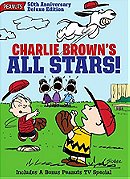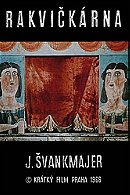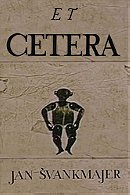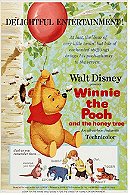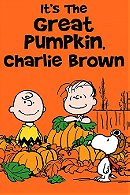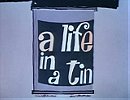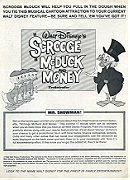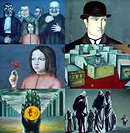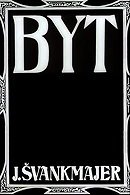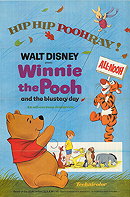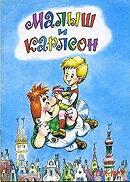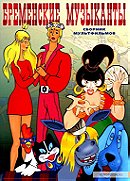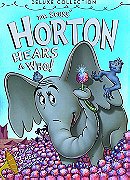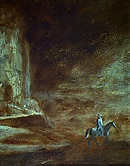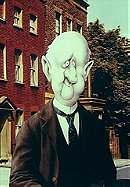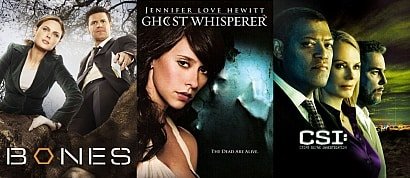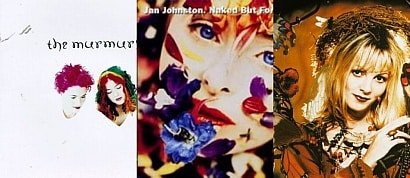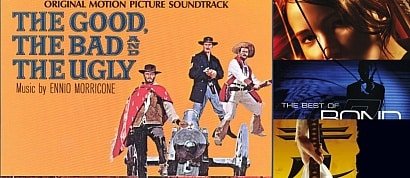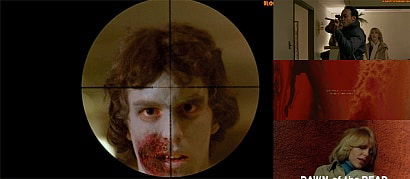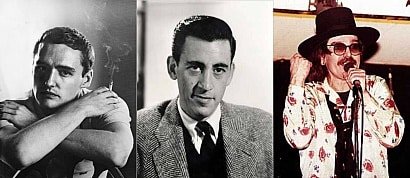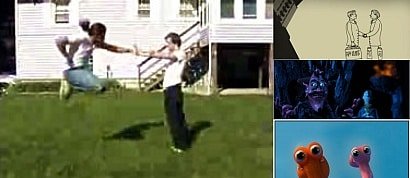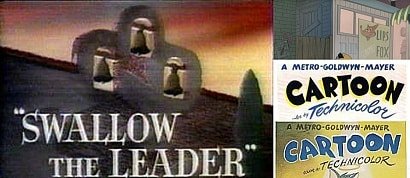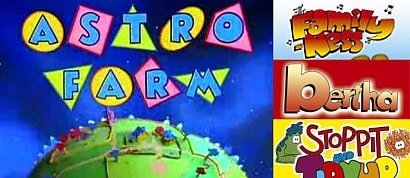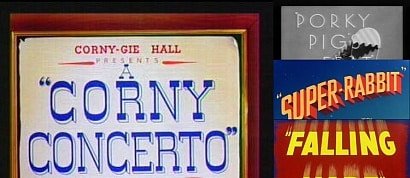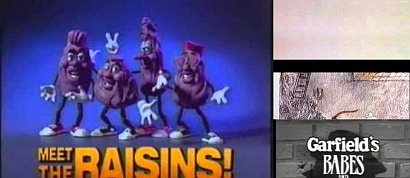1001 Animated Shorts You Must See - Part 9
Sort by:
Showing 50 items
Decade:
Rating:
List Type:
DIR: Ryan Larkin
SUMMARY: A satyr serenades a water nymph.
WHY IT'S HERE: Ryan Larkin's first film, overseen by Norman McLaren, immediately shows the promise of this tragically wasted talent who in the early 70s succumbed to cocaine, alcohol and homelessness for decades. In its short 3 minutes, 'Syrinx' tells the mythical story of Pan creating his pipes. There's not much in the way of event here but Larkin's eye-popping charcoal animations create a ravishing visual experience. Larkin would continue to make deceptively simple premises into captivatingly beautiful animations for his brief career, which ended up dwarfing 'Syrinx' in terms of both quality and importance. Ultimately though, this is a very impressive starting point.
SUMMARY: A satyr serenades a water nymph.
WHY IT'S HERE: Ryan Larkin's first film, overseen by Norman McLaren, immediately shows the promise of this tragically wasted talent who in the early 70s succumbed to cocaine, alcohol and homelessness for decades. In its short 3 minutes, 'Syrinx' tells the mythical story of Pan creating his pipes. There's not much in the way of event here but Larkin's eye-popping charcoal animations create a ravishing visual experience. Larkin would continue to make deceptively simple premises into captivatingly beautiful animations for his brief career, which ended up dwarfing 'Syrinx' in terms of both quality and importance. Ultimately though, this is a very impressive starting point.
DIR: Bill Melendez
SUMMARY: Charlie Brown has to make a difficult moral decision when his baseball team gets the opportunity to join the Little League.
WHY IT'S HERE: 'Charlie Brown's All Stars!' was the second Peanuts TV special and, despite being nowhere near as famous as the Christmas and Halloween specials that bookend it, this summer baseball themed short is every bit as great. Focusing on the little league baseball which played such a big part in the comic strips, 'Charlie Brown's All Stars!' is based around an interesting moral dilemma as Charlie's baseball team is offered sponsorship and new uniforms by a local business but is then told that this will only be the case for the boys, with girls and dogs not being allowed to play. Charlie turns down the offer in favour of keeping the girls and Snoopy on the team but still incurs the wrath of his teammates. The story follows a similar arc to the Christmas special, with Charlie finally being redeemed in the eyes of his friends, although the final images feel much more melancholy as Charlie's determination to win the next days game are quashed by rain. The short ends with Charlie and Linus standing together on the baseball field getting quietly drenched.
SUMMARY: Charlie Brown has to make a difficult moral decision when his baseball team gets the opportunity to join the Little League.
WHY IT'S HERE: 'Charlie Brown's All Stars!' was the second Peanuts TV special and, despite being nowhere near as famous as the Christmas and Halloween specials that bookend it, this summer baseball themed short is every bit as great. Focusing on the little league baseball which played such a big part in the comic strips, 'Charlie Brown's All Stars!' is based around an interesting moral dilemma as Charlie's baseball team is offered sponsorship and new uniforms by a local business but is then told that this will only be the case for the boys, with girls and dogs not being allowed to play. Charlie turns down the offer in favour of keeping the girls and Snoopy on the team but still incurs the wrath of his teammates. The story follows a similar arc to the Christmas special, with Charlie finally being redeemed in the eyes of his friends, although the final images feel much more melancholy as Charlie's determination to win the next days game are quashed by rain. The short ends with Charlie and Linus standing together on the baseball field getting quietly drenched.
DIR: Alex Lovy
SUMMARY: A hip, animated think piece which takes place in the titular character's head as he struggles to maintain his peronal ethics.
WHY IT'S HERE: Alex Lovy's 'Norman Normal' is an exceptional little satire on business ethics and social behaviour. Produced by the new Warner Bros. department in the late 60s (long after the dreadful Speedy and Daffy series and lacklustre new characters such as Cool Cat had made Warner cartoons seem entirely past their best) as a "Cartoon Special", 'Norman Normal' takes an entirely different approach as a hip animated think piece which ultimately takes place inside the titular character's head. The amiable Norman must fight off unethical propositions from his boss, endorsements of conformity from his father, peer pressure from his acquaintances and the desperate search for approval by a man with a lamp on his head! A whole new contemporary attitude is apparent, especially in the scene in which Norman refuses to laugh at a joke about a minority group which seems like an apology for Warner's decades of politically incorrect racial humour (although a year later Warner Bros. animation department would close down with a short called 'Injun Trouble'!). The satire is sharp and funny and the modern atmosphere is enhanced by a catchy theme tune by Peter, Paul and Mary. It may have little in common with the golden era of Warner cartoons but 'Norman Normal' is a wonderful short and one of the few latter day Warner shorts that really works.
SUMMARY: A hip, animated think piece which takes place in the titular character's head as he struggles to maintain his peronal ethics.
WHY IT'S HERE: Alex Lovy's 'Norman Normal' is an exceptional little satire on business ethics and social behaviour. Produced by the new Warner Bros. department in the late 60s (long after the dreadful Speedy and Daffy series and lacklustre new characters such as Cool Cat had made Warner cartoons seem entirely past their best) as a "Cartoon Special", 'Norman Normal' takes an entirely different approach as a hip animated think piece which ultimately takes place inside the titular character's head. The amiable Norman must fight off unethical propositions from his boss, endorsements of conformity from his father, peer pressure from his acquaintances and the desperate search for approval by a man with a lamp on his head! A whole new contemporary attitude is apparent, especially in the scene in which Norman refuses to laugh at a joke about a minority group which seems like an apology for Warner's decades of politically incorrect racial humour (although a year later Warner Bros. animation department would close down with a short called 'Injun Trouble'!). The satire is sharp and funny and the modern atmosphere is enhanced by a catchy theme tune by Peter, Paul and Mary. It may have little in common with the golden era of Warner cartoons but 'Norman Normal' is a wonderful short and one of the few latter day Warner shorts that really works.
DIR: David Lynch
SUMMARY: A continuous loop of six vomiting figures.
WHY IT'S HERE: 'Six Men Getting Sick' was the first film of David Lynch, the brilliant director who went on make some of the most unique films of the 20th century and beyond. A student project experimenting with animation and made to be projected onto a specially sculpted screen on a continuous loop, 'Six Men Getting Sick' still works well when seen on an ordinary screen just once or twice through (although the film's subtitle suggests watching it through at least six times). In keeping with the disturbing imagery Lynch would become renowned for, 'Six Men Getting Sick' depicts six figures with visible internal workings, which slowly fill up with a brightly coloured substance which then rises up and oozes out of their mouths, accompanied by the urgent howls of a siren. It sounds gratuitous and tasteless but Lynch subtly imbues the film with his troubling sense of humour and expert way with an indelible image.
SUMMARY: A continuous loop of six vomiting figures.
WHY IT'S HERE: 'Six Men Getting Sick' was the first film of David Lynch, the brilliant director who went on make some of the most unique films of the 20th century and beyond. A student project experimenting with animation and made to be projected onto a specially sculpted screen on a continuous loop, 'Six Men Getting Sick' still works well when seen on an ordinary screen just once or twice through (although the film's subtitle suggests watching it through at least six times). In keeping with the disturbing imagery Lynch would become renowned for, 'Six Men Getting Sick' depicts six figures with visible internal workings, which slowly fill up with a brightly coloured substance which then rises up and oozes out of their mouths, accompanied by the urgent howls of a siren. It sounds gratuitous and tasteless but Lynch subtly imbues the film with his troubling sense of humour and expert way with an indelible image.
DIR: Norman McLaren, Evelyn Lambart
SUMMARY: A Ping-Pong ball set in motion begins to divide as it touches the side of the screen.
WHY IT'S HERE: Norman McLaren and Evelyn Lambart's 'Mosaic' is an ingenious twist on the abstract film in which a man sets a ping pong ball flying across the screen and each time it touches something it divides into more balls, eventually filling the screen with different patterns that all stemmed from that original little dot. With the art of abstract animation now being several decades old, new angles were important in keeping it fresh and McLaren and Lambart have come up with a great idea to do just that. It goes on for a few minutes too long to sustain interest but 'Mosaic' is remarkable for its ability to transform an audience's perception of abstract shapes and patterns by simply relating them to an opening image that seems to reveal the mechanics behind their creation.
SUMMARY: A Ping-Pong ball set in motion begins to divide as it touches the side of the screen.
WHY IT'S HERE: Norman McLaren and Evelyn Lambart's 'Mosaic' is an ingenious twist on the abstract film in which a man sets a ping pong ball flying across the screen and each time it touches something it divides into more balls, eventually filling the screen with different patterns that all stemmed from that original little dot. With the art of abstract animation now being several decades old, new angles were important in keeping it fresh and McLaren and Lambart have come up with a great idea to do just that. It goes on for a few minutes too long to sustain interest but 'Mosaic' is remarkable for its ability to transform an audience's perception of abstract shapes and patterns by simply relating them to an opening image that seems to reveal the mechanics behind their creation.
Punch and Judy (1966)
DIR: Jan Svankmajer
SUMMARY: Punch and Judy engage in a fight to the death over a guinea pig.
WHY IT'S HERE: Jan Svankmajer's 'Punch and Judy' is a classic of puppet animation which typifies the grotesquery of some of the director's most famous work, including his 1980s feature 'Alice'. It follows the story of Punch and Judy's fight to the death over custody of a live action guinea pig. As Punch and Judy's war becomes more vicious, with mallets, nails and coffins coming into play, the guinea pig remains hilariously indifferent, apparently oblivious to the whole thing. 'Punch and Judy' manages to expose its famous bad-taste seaside attraction as the horrifying freak show it is while also tapping into why audiences have found it so frequently entertaining. Why this sort of thing is associated with days at the beach, ice creams and lemonade is anybody's guess and by removing it from this context and placing the story into an audience-free dark corner of nowhere, Svankmajer creates a haunting comedy of brutal extremes.
SUMMARY: Punch and Judy engage in a fight to the death over a guinea pig.
WHY IT'S HERE: Jan Svankmajer's 'Punch and Judy' is a classic of puppet animation which typifies the grotesquery of some of the director's most famous work, including his 1980s feature 'Alice'. It follows the story of Punch and Judy's fight to the death over custody of a live action guinea pig. As Punch and Judy's war becomes more vicious, with mallets, nails and coffins coming into play, the guinea pig remains hilariously indifferent, apparently oblivious to the whole thing. 'Punch and Judy' manages to expose its famous bad-taste seaside attraction as the horrifying freak show it is while also tapping into why audiences have found it so frequently entertaining. Why this sort of thing is associated with days at the beach, ice creams and lemonade is anybody's guess and by removing it from this context and placing the story into an audience-free dark corner of nowhere, Svankmajer creates a haunting comedy of brutal extremes.
There Lived Kozyavin (1966)
DIR:Andrey Khrzhanovsky
SUMMARY: Asked to go and fetch a fellow employee and pointed in the vague direction that his boss thinks he may be located, an office employee walks all the way around the world in a straight line in an attempt to comply.
WHY IT'S HERE: Russian director Andrey Khrzhanovskiy's 'There Lived Kozyavin' is a simple but brilliant satire on conformity and the soul-deadening experience of working for a faceless, exploitative employer. It brings to mind the civil servants of Gogol's surrealist short stories, with which it shares an absurdist, grotesque sense of humour. Following Kozyavin on his trip around the world as he searches calmly and blankly for a colleague he will blatantly never find after the first few minutes of searching, 'There Lived Kozyavin' features brilliant artwork which foreshadows similar designs by Bill Plympton decades later. The characters are eerily, aptly expressionless and drift aimlessly through their seemingly empty existences with a haunting acceptance. As indictments of the conformist 9 to 5 existence go, 'There Lived Kozyavin' ranks among the most memorable.
SUMMARY: Asked to go and fetch a fellow employee and pointed in the vague direction that his boss thinks he may be located, an office employee walks all the way around the world in a straight line in an attempt to comply.
WHY IT'S HERE: Russian director Andrey Khrzhanovskiy's 'There Lived Kozyavin' is a simple but brilliant satire on conformity and the soul-deadening experience of working for a faceless, exploitative employer. It brings to mind the civil servants of Gogol's surrealist short stories, with which it shares an absurdist, grotesque sense of humour. Following Kozyavin on his trip around the world as he searches calmly and blankly for a colleague he will blatantly never find after the first few minutes of searching, 'There Lived Kozyavin' features brilliant artwork which foreshadows similar designs by Bill Plympton decades later. The characters are eerily, aptly expressionless and drift aimlessly through their seemingly empty existences with a haunting acceptance. As indictments of the conformist 9 to 5 existence go, 'There Lived Kozyavin' ranks among the most memorable.
DIR: Chuck Jones
SUMMARY: The Grinch, a bitter creature with a heart two sizes too small, lives in an isolated cave on top of a mountain overlooking Whoville. The Grinch especially despises Christmas and after 53 years of watching it in disgust, he decides that this year he's going to steal the entire holiday.
WHY IT'S HERE: The dream union of Chuck Jones and Dr. Seuss had been brought together previously for the short Private Snafu army training cartoons but this TV Christmas special based on Seuss's much loved book of the same title brought out the full potential of the partnership. 'How the Grinch Stole Christmas' has become a seasonal TV staple and it stands out above other such fare because Jones's expert approach is very much in evidence, Seuss's script is exceptional and Boris Karloff's narration is worthy of the great actor's legendary catalogue of credits. Also brilliant is Thurl Ravenscroft, the legendary voice behind Frosties icon Tony the Tiger. Ravenscroft sings the hilarious 'You're a Mean One, Mr. Grinch', an alternative Christmas hit in any household that has embraced this festive classic.
SUMMARY: The Grinch, a bitter creature with a heart two sizes too small, lives in an isolated cave on top of a mountain overlooking Whoville. The Grinch especially despises Christmas and after 53 years of watching it in disgust, he decides that this year he's going to steal the entire holiday.
WHY IT'S HERE: The dream union of Chuck Jones and Dr. Seuss had been brought together previously for the short Private Snafu army training cartoons but this TV Christmas special based on Seuss's much loved book of the same title brought out the full potential of the partnership. 'How the Grinch Stole Christmas' has become a seasonal TV staple and it stands out above other such fare because Jones's expert approach is very much in evidence, Seuss's script is exceptional and Boris Karloff's narration is worthy of the great actor's legendary catalogue of credits. Also brilliant is Thurl Ravenscroft, the legendary voice behind Frosties icon Tony the Tiger. Ravenscroft sings the hilarious 'You're a Mean One, Mr. Grinch', an alternative Christmas hit in any household that has embraced this festive classic.
Et Cetera (1966)
DIR: Jan Svankmajer
SUMMARY: Small, animated figures learns how to use a whip, a pair of wings and a house.
WHY IT'S HERE: Jan Svankmajer's 'Et Cetera' is a great cut-out animation that focuses on three separate sequences of events in which a man learns to fly using increasingly larger sets of wings, a man uses a whip to train a beast and a man creates himself a series of houses. From this straightforward premise, Svankmajer makes a vague satirical point about the pointlessness of man's endeavours and the perpetual repetition of these futile efforts throughout history. The profundity of the message is not the point here however, instead 'Et Cetera' draws laughter from its thoughtfully repetitious and oddly compelling and entertaining cycles.
SUMMARY: Small, animated figures learns how to use a whip, a pair of wings and a house.
WHY IT'S HERE: Jan Svankmajer's 'Et Cetera' is a great cut-out animation that focuses on three separate sequences of events in which a man learns to fly using increasingly larger sets of wings, a man uses a whip to train a beast and a man creates himself a series of houses. From this straightforward premise, Svankmajer makes a vague satirical point about the pointlessness of man's endeavours and the perpetual repetition of these futile efforts throughout history. The profundity of the message is not the point here however, instead 'Et Cetera' draws laughter from its thoughtfully repetitious and oddly compelling and entertaining cycles.
Lapis (1966)
DIR: James Whitney
SUMMARY: An early computer-aided animation based around the flow of images of the mandala
WHY IT'S HERE: James Whitney is considered one of the great masters of abstract animation and even a cursory glance at 'Lapis' shows why. Whitney had worked on several ambitious projects prior to this but analogue computer equipment developed by his brother John allowed Whitney to complete 'Lapis' in just two years. A spellbinding kaleidoscope of a film, 'Lapis' was created using drawn dot patterns which were then shot with a computer-positioned camera allowing images to be overlaid from multiple angles. Whitney added sitar music and the result is hypnotically compelling and a clear sign of the progression of abstract animation.
SUMMARY: An early computer-aided animation based around the flow of images of the mandala
WHY IT'S HERE: James Whitney is considered one of the great masters of abstract animation and even a cursory glance at 'Lapis' shows why. Whitney had worked on several ambitious projects prior to this but analogue computer equipment developed by his brother John allowed Whitney to complete 'Lapis' in just two years. A spellbinding kaleidoscope of a film, 'Lapis' was created using drawn dot patterns which were then shot with a computer-positioned camera allowing images to be overlaid from multiple angles. Whitney added sitar music and the result is hypnotically compelling and a clear sign of the progression of abstract animation.
The Snails (1966)
DIR: Rene Laloux
SUMMARY: When a group of snails feast on a gardener's huge plants, the snails in turn grow to an unusual size.
WHY IT'S HERE: Unlike his hauntingly strange first short 'Monkey's Teeth' or his subsequent feature 'Fantastic Planet', Rene Laloux's 'The Snails' is a film played for laughs. With a rudimentary but effective animation style enhanced by the great artwork, 'The Snails' follows the story of a farmer who discovers he can make his crops grow to enormous sizes by watering them with his tears. But this also results in the pests that feed on them taking on similarly gargantuan proportions. The subsequent snail attack on the city parodies the likes of 'King Kong' and 'Godzilla' and while it could have been all out boffo comedy, Laloux's personal style shines through to make it just a little troubling as well, particularly a moment when a snail takes a shine to a scantily clad lady. But the very funny punchline makes it clear that 'The Snails' is intended to be a rare foray into comedy for one of animation's most clinically cold directors.
SUMMARY: When a group of snails feast on a gardener's huge plants, the snails in turn grow to an unusual size.
WHY IT'S HERE: Unlike his hauntingly strange first short 'Monkey's Teeth' or his subsequent feature 'Fantastic Planet', Rene Laloux's 'The Snails' is a film played for laughs. With a rudimentary but effective animation style enhanced by the great artwork, 'The Snails' follows the story of a farmer who discovers he can make his crops grow to enormous sizes by watering them with his tears. But this also results in the pests that feed on them taking on similarly gargantuan proportions. The subsequent snail attack on the city parodies the likes of 'King Kong' and 'Godzilla' and while it could have been all out boffo comedy, Laloux's personal style shines through to make it just a little troubling as well, particularly a moment when a snail takes a shine to a scantily clad lady. But the very funny punchline makes it clear that 'The Snails' is intended to be a rare foray into comedy for one of animation's most clinically cold directors.
Mister Rossi Buys a Car (1966)
DIR: Bruno Bozzetto
SUMMARY: When Mister Rossi buys himself a car, he quickly becomes a menace to other road users.
WHY IT'S HERE: Up to this point, Bruno Bozzetto's Mr. Rossi shorts had been gently satirical gag-based cartoons following the adventures of everyman Mr. Rossi in a series of everyday activities. 'Mister Rossi Buys a Car', probably the best of this fantastic series, marks the moment when the Rossi shorts start to take a turn for the dark. Beginning in the usual gag-heavy mould as Mr. Rossi observes how everyone but him has an automobile and decides to purchase one, 'Mister Rossi Buys a Car' changes significantly once he hits the road. Running into pretty much every little irritation a motorist could dread, Rossi's reaction is to become a psychotic maniac determined to destroy everything and everyone in his path. A prophetic look a road rage decades before the term was coined, 'Mister Rossi Buys a Car' is a superb satire that keeps the laughs coming but also establishes a second act switch in which it becomes deeply troubling as well. The short ends with Rossi reduced to a shell of a man, psychologically broken and attempting to drive a hospital bed like a car while he is observed by hordes of curious doctors. Amazingly, the Rossi shorts would continue to plumb even darker depths after this, before the feature length films Bozzetto made with the character introduced dialogue and a talking dog sidekick and retooled Rossi as primarily a children's entertainment. For those, like myself, who grew up with that Rossi, 'Mister Rossi Buys a Car' is a shocking discovery!
SUMMARY: When Mister Rossi buys himself a car, he quickly becomes a menace to other road users.
WHY IT'S HERE: Up to this point, Bruno Bozzetto's Mr. Rossi shorts had been gently satirical gag-based cartoons following the adventures of everyman Mr. Rossi in a series of everyday activities. 'Mister Rossi Buys a Car', probably the best of this fantastic series, marks the moment when the Rossi shorts start to take a turn for the dark. Beginning in the usual gag-heavy mould as Mr. Rossi observes how everyone but him has an automobile and decides to purchase one, 'Mister Rossi Buys a Car' changes significantly once he hits the road. Running into pretty much every little irritation a motorist could dread, Rossi's reaction is to become a psychotic maniac determined to destroy everything and everyone in his path. A prophetic look a road rage decades before the term was coined, 'Mister Rossi Buys a Car' is a superb satire that keeps the laughs coming but also establishes a second act switch in which it becomes deeply troubling as well. The short ends with Rossi reduced to a shell of a man, psychologically broken and attempting to drive a hospital bed like a car while he is observed by hordes of curious doctors. Amazingly, the Rossi shorts would continue to plumb even darker depths after this, before the feature length films Bozzetto made with the character introduced dialogue and a talking dog sidekick and retooled Rossi as primarily a children's entertainment. For those, like myself, who grew up with that Rossi, 'Mister Rossi Buys a Car' is a shocking discovery!
Chromophobia (1966)
DIR: Raoul Servais
SUMMARY: An invading army destroys all the colour in a town but the arrival of a jester may turn things around.
WHY IT'S HERE: Belgian animator Raoul Servais's anti-militarist fable about an army of monochrome soldiers who set about erasing all the colour in a formerly happy land is an unsubtle but effective attack on conformity and enforced viewpoints. The use of the juxtaposition between colour and black and white is fantastic, with the switching between the two and the associated emotions carrying the viewer on a back-and-forth emotional ride. Although it has a serious message, 'Chromophobia' is also largely presented in a humorous way, with the character designs, animation and plot all keeping things agreeably light.
SUMMARY: An invading army destroys all the colour in a town but the arrival of a jester may turn things around.
WHY IT'S HERE: Belgian animator Raoul Servais's anti-militarist fable about an army of monochrome soldiers who set about erasing all the colour in a formerly happy land is an unsubtle but effective attack on conformity and enforced viewpoints. The use of the juxtaposition between colour and black and white is fantastic, with the switching between the two and the associated emotions carrying the viewer on a back-and-forth emotional ride. Although it has a serious message, 'Chromophobia' is also largely presented in a humorous way, with the character designs, animation and plot all keeping things agreeably light.
DIR: Wolfgang Reitherman
SUMMARY: While visiting his friend Rabbit, Winnie the Pooh gets himself stuck in his doorway.
WHY IT'S HERE: The first of Disney's massively successful Winnie the Pooh shorts, 'Winnie the Pooh and the Honey Tree' is an extraordinarily charming adaptation of A.A. Milne's work which unsurprisingly spawned a series of shorts which were later consolidated into the 1977 feature 'The Many Adventures of Winnie the Pooh'. Focusing on the first two chapters of Milne's book 'Winnie-the-Pooh', 'Winnie the Pooh and the Honey Tree' tells the gentle tale of a bear of very little brain who, in his quest for honey, ends up getting himself stuck in his friend Rabbit's doorway. There are many great touches here, particularly casting Sebastian Cabot as narrator and having the characters actually walk around in a giant storybook, hopping across the book's spine and interacting with the written text. Most of the well-loved characters are in place, including Christopher Robin (whose childhood wonderland is so exquisitely captured), Eeyore, Owl, Kanga and Roo, although the unusual decision to replace Piglet with a gopher caused much public outcry and was reversed in the following short 'Winnie the Pooh and the Blustery Day'. Although it was great to have Piglet in place, the gopher is a great character too. An independent tradesman, he repeatedly tells his clients "I'm not in the book, you know", one of the cleverest jokes in the whole film.
SUMMARY: While visiting his friend Rabbit, Winnie the Pooh gets himself stuck in his doorway.
WHY IT'S HERE: The first of Disney's massively successful Winnie the Pooh shorts, 'Winnie the Pooh and the Honey Tree' is an extraordinarily charming adaptation of A.A. Milne's work which unsurprisingly spawned a series of shorts which were later consolidated into the 1977 feature 'The Many Adventures of Winnie the Pooh'. Focusing on the first two chapters of Milne's book 'Winnie-the-Pooh', 'Winnie the Pooh and the Honey Tree' tells the gentle tale of a bear of very little brain who, in his quest for honey, ends up getting himself stuck in his friend Rabbit's doorway. There are many great touches here, particularly casting Sebastian Cabot as narrator and having the characters actually walk around in a giant storybook, hopping across the book's spine and interacting with the written text. Most of the well-loved characters are in place, including Christopher Robin (whose childhood wonderland is so exquisitely captured), Eeyore, Owl, Kanga and Roo, although the unusual decision to replace Piglet with a gopher caused much public outcry and was reversed in the following short 'Winnie the Pooh and the Blustery Day'. Although it was great to have Piglet in place, the gopher is a great character too. An independent tradesman, he repeatedly tells his clients "I'm not in the book, you know", one of the cleverest jokes in the whole film.
DIR: John Hubley, Faith Hubley
SUMMARY: Two famous Herb Alpert numbers, 'Spanish Flea' and 'Tijuana Taxi' are set to some loose, amusing animated sequences.
WHY IT'S HERE: Considered an early example of a music video, 'A Herb Alpert & the Tijuana Brass Double Feature' won John and Faith Hubley their third Oscar but it is very different from their heavily dialogue-based previous winners. In fact, 'A Herb Alpert & the Tijuana Brass Double Feature' features no dialogue whatsoever and is instead soundtracked by two lively, upbeat and very famous musical numbers by the titular band. The lively, sketchy creations that dance along to the music bring it to life and vice versa, with this perfect marriage of image and soundtrack obviously playing a great part in winning the film its award. Amidst the Hubley's heavyweight output, 'A Herb Alpert & the Tijuana Brass Double Feature' may be seen as a throwaway effort but it is actually a terrific piece which combines a carefree, loose approach with a well hidden expertise for exact orchestration.
SUMMARY: Two famous Herb Alpert numbers, 'Spanish Flea' and 'Tijuana Taxi' are set to some loose, amusing animated sequences.
WHY IT'S HERE: Considered an early example of a music video, 'A Herb Alpert & the Tijuana Brass Double Feature' won John and Faith Hubley their third Oscar but it is very different from their heavily dialogue-based previous winners. In fact, 'A Herb Alpert & the Tijuana Brass Double Feature' features no dialogue whatsoever and is instead soundtracked by two lively, upbeat and very famous musical numbers by the titular band. The lively, sketchy creations that dance along to the music bring it to life and vice versa, with this perfect marriage of image and soundtrack obviously playing a great part in winning the film its award. Amidst the Hubley's heavyweight output, 'A Herb Alpert & the Tijuana Brass Double Feature' may be seen as a throwaway effort but it is actually a terrific piece which combines a carefree, loose approach with a well hidden expertise for exact orchestration.
DIR: Bill Melendez
SUMMARY: During Halloween, Linus waits eagerly for a visit from the Great Pumpkin.
WHY IT'S HERE: The third Peanuts TV special and probably the second most popular after the Christmas special, 'It's the Great Pumpkin, Charlie Brown' is a Halloween themed short which focuses largely on Linus rather than Charlie Brown. The storyline, in which Linus waits in vain for The Great Pumpkin to visit on Halloween, is a typically melancholy and unusual Schulz plot. Although there are other little skits surrounding it (including the famous trick or treating sequence in which Charlie repeatedly gets given rocks, and the first appearance of Snoopy as his alter ego The Red Baron), Linus's story is a heartbreaking look at unerring faith in the face of evidence to the contrary. Although there were unfounded rumours that the first time the special aired there was a scene where the Great Pumpkin actually turns up, these were probably born of people misremembering due to their narrative expectations. In fact, the short ends with Linus rambling over the credits about how the Great Pumpkin will definitely come next year. Narrative expectations are rarely met in Peanuts shorts, which is why they are so enduringly fascinating and popular. 'It's the Great Pumpkin, Charlie Brown' is another classic TV special.
SUMMARY: During Halloween, Linus waits eagerly for a visit from the Great Pumpkin.
WHY IT'S HERE: The third Peanuts TV special and probably the second most popular after the Christmas special, 'It's the Great Pumpkin, Charlie Brown' is a Halloween themed short which focuses largely on Linus rather than Charlie Brown. The storyline, in which Linus waits in vain for The Great Pumpkin to visit on Halloween, is a typically melancholy and unusual Schulz plot. Although there are other little skits surrounding it (including the famous trick or treating sequence in which Charlie repeatedly gets given rocks, and the first appearance of Snoopy as his alter ego The Red Baron), Linus's story is a heartbreaking look at unerring faith in the face of evidence to the contrary. Although there were unfounded rumours that the first time the special aired there was a scene where the Great Pumpkin actually turns up, these were probably born of people misremembering due to their narrative expectations. In fact, the short ends with Linus rambling over the credits about how the Great Pumpkin will definitely come next year. Narrative expectations are rarely met in Peanuts shorts, which is why they are so enduringly fascinating and popular. 'It's the Great Pumpkin, Charlie Brown' is another classic TV special.
Life in a Tin (1967)
DIR: Bruno Bozzetto
SUMMARY: A condensed depiction of one man's entire life.
WHY IT'S HERE: Bruno Bozzetto's 'Life in a Tin' is part of a minimalist duo of films the director made in 1967, the other being the super-minimalist sketch 'Two Castles'. 'Life in a Tin' examines the entire lifespan of a man from his birth to his death. This is mostly depicted through pans between buildings accompanied by sound effects symbolising times of the day like the end of work or waking up. The effect is to pare back the depiction of life to something as minimalist as the animation itself. 'Life in a Tin' may sound like a depressing idea but it also includes snatches of moments when life seems wonderful, symbolised by a sudden slowing down of pace, woozy music and the arrival of bright flowers which disappear the minute the man is jarred back into his reality. The implication seems to be that there is little time to stop and smell the flowers in life and it's all a big, frenzied and ultimately pointless endeavour but to watch 'Life in a Tin' is to experience more. The lovingly-made short seems to have an appreciation for life even as it ridicules it. After all, when you readjust a lifetime to fit the timeframe provided here, those happy moments last longer than they seem to here.
SUMMARY: A condensed depiction of one man's entire life.
WHY IT'S HERE: Bruno Bozzetto's 'Life in a Tin' is part of a minimalist duo of films the director made in 1967, the other being the super-minimalist sketch 'Two Castles'. 'Life in a Tin' examines the entire lifespan of a man from his birth to his death. This is mostly depicted through pans between buildings accompanied by sound effects symbolising times of the day like the end of work or waking up. The effect is to pare back the depiction of life to something as minimalist as the animation itself. 'Life in a Tin' may sound like a depressing idea but it also includes snatches of moments when life seems wonderful, symbolised by a sudden slowing down of pace, woozy music and the arrival of bright flowers which disappear the minute the man is jarred back into his reality. The implication seems to be that there is little time to stop and smell the flowers in life and it's all a big, frenzied and ultimately pointless endeavour but to watch 'Life in a Tin' is to experience more. The lovingly-made short seems to have an appreciation for life even as it ridicules it. After all, when you readjust a lifetime to fit the timeframe provided here, those happy moments last longer than they seem to here.
The Question (1967)
DIR: John Halas
SUMMARY: A man finds a question mark on the floor and consults a range of experts to find an answer to the vague question.
WHY IT'S HERE: Halas and Batchelor's 'The Question' is a lovely little humanist short, its hippy ideals of love instantly marking it out as being from 1967. A philosophical but comically appealing short about a man who finds a question mark on the floor and sets about finding out the answer to this non-specific question, 'The Question' essentially denounces everything from religion to politics and art to psychiatry, ultimately proffering love as the answer to everything. It may sound somewhat naïve and dated but, even as I’ve grown up and gone through years of cynicism, there’s always been an element of the All You Need is Love philosophy that has remained central to my own beliefs so this short appeals to me on that level but can be enjoyed as a wonderfully realised little think piece whether you agree with its central idea or not.
SUMMARY: A man finds a question mark on the floor and consults a range of experts to find an answer to the vague question.
WHY IT'S HERE: Halas and Batchelor's 'The Question' is a lovely little humanist short, its hippy ideals of love instantly marking it out as being from 1967. A philosophical but comically appealing short about a man who finds a question mark on the floor and sets about finding out the answer to this non-specific question, 'The Question' essentially denounces everything from religion to politics and art to psychiatry, ultimately proffering love as the answer to everything. It may sound somewhat naïve and dated but, even as I’ve grown up and gone through years of cynicism, there’s always been an element of the All You Need is Love philosophy that has remained central to my own beliefs so this short appeals to me on that level but can be enjoyed as a wonderfully realised little think piece whether you agree with its central idea or not.
Cages (1967)
DIR: Miroslaw Kijowicz
SUMMARY: A prisoner in solitary confinement is kept in constant check by the watchful guard.
WHY IT'S HERE: Polish director Miroslaw Kijowicz's 'Klatki' is one of the most powerful animated shorts of the 60s. Through simple line drawings, Kijowicz sets up a situation which communicates so much through its direct but effective symbolism. 'Klatki' shows a prisoner in solitary confinement whose guard initially takes pity on him and presents him with some building blocks to amuse himself with. But when the guard disapproves of the shapes he builds with them, they are taken away. This is just the first in a series of oppressive acts by the initially sympathetic guard which drive the prisoner to ever more desperate acts to fill his time or escape his cell. Without giving anything away, the denouement here is one of the most haunting endings I've ever seen and the sound effects over the prolonged blackout at the finale resonate for a long time after the film has ended.
SUMMARY: A prisoner in solitary confinement is kept in constant check by the watchful guard.
WHY IT'S HERE: Polish director Miroslaw Kijowicz's 'Klatki' is one of the most powerful animated shorts of the 60s. Through simple line drawings, Kijowicz sets up a situation which communicates so much through its direct but effective symbolism. 'Klatki' shows a prisoner in solitary confinement whose guard initially takes pity on him and presents him with some building blocks to amuse himself with. But when the guard disapproves of the shapes he builds with them, they are taken away. This is just the first in a series of oppressive acts by the initially sympathetic guard which drive the prisoner to ever more desperate acts to fill his time or escape his cell. Without giving anything away, the denouement here is one of the most haunting endings I've ever seen and the sound effects over the prolonged blackout at the finale resonate for a long time after the film has ended.
Arès contre Atlas (1967)
DIR: Manolo Otero
SUMMARY: A series of blackly comic scenes from the war between two nations.
WHY IT'S HERE: Manolo Otero's 'Ares contre Atlas' is a brilliant satire on the futility and ridiculousness of war which, in a series of blackout gags, skilfully unearths the humour inherent in the darkest corners of mankind's nature. The style is reminiscent of satirical newspaper cartoons, with each scene building to a big laugh and ending immediately. Far from being predictable, the laughs are unexpected and often designed specifically to wrongfoot the viewer. While it doesn't necessarily have any great profound statement to make, 'Ares contre Atlas' is one of the most concisely effective depictions of the laughter to be found in the grimmest depths of human nature.
SUMMARY: A series of blackly comic scenes from the war between two nations.
WHY IT'S HERE: Manolo Otero's 'Ares contre Atlas' is a brilliant satire on the futility and ridiculousness of war which, in a series of blackout gags, skilfully unearths the humour inherent in the darkest corners of mankind's nature. The style is reminiscent of satirical newspaper cartoons, with each scene building to a big laugh and ending immediately. Far from being predictable, the laughs are unexpected and often designed specifically to wrongfoot the viewer. While it doesn't necessarily have any great profound statement to make, 'Ares contre Atlas' is one of the most concisely effective depictions of the laughter to be found in the grimmest depths of human nature.
The Mitten (1967)
DIR: Roman Kachanov
SUMMARY: A little girl who is forbidden from adopting a neighbour's puppy imagines her mitten is a dog.
WHY IT'S HERE: Roman Kachanov's 'The Mitten' is a charming, sweet classic of Russian puppet animation. Set against a snowy winter backdrop, 'The Mitten' unlocks the door to a young girl's imagination as she conjures up a small, red, knitted puppy from her mitten so she can play alongside the neighbourhood dog owners and their real pooches. The puppets, particularly the girl, the dog and the girl's distant mother, are wonderfully emotive through the smallest movements, enhanced by their blinking eyes and changing expressions that differentiates them from forerunners like Jiri Trnka's marionettes. The simple story taps into the audiences emotions without being too sentimental, making it winningly touching rather than exploitatively cloying. Kachanov, who would go on to make the 'Cheburashka' trilogy and the classic 80s animated feature 'Mystery of the Third Planet', made an indelible mark with 'The Mitten' which was embraced as a classic of Russian animation.
SUMMARY: A little girl who is forbidden from adopting a neighbour's puppy imagines her mitten is a dog.
WHY IT'S HERE: Roman Kachanov's 'The Mitten' is a charming, sweet classic of Russian puppet animation. Set against a snowy winter backdrop, 'The Mitten' unlocks the door to a young girl's imagination as she conjures up a small, red, knitted puppy from her mitten so she can play alongside the neighbourhood dog owners and their real pooches. The puppets, particularly the girl, the dog and the girl's distant mother, are wonderfully emotive through the smallest movements, enhanced by their blinking eyes and changing expressions that differentiates them from forerunners like Jiri Trnka's marionettes. The simple story taps into the audiences emotions without being too sentimental, making it winningly touching rather than exploitatively cloying. Kachanov, who would go on to make the 'Cheburashka' trilogy and the classic 80s animated feature 'Mystery of the Third Planet', made an indelible mark with 'The Mitten' which was embraced as a classic of Russian animation.
Scrooge McDuck and Money (1967)
DIR: Hamilton Luske
SUMMARY: Scrooge McDuck gives a lecture on finance to his nephews Huey, Dewey and Louie.
WHY IT'S HERE: 'Scrooge McDuck and Money' is an educational featurette that is mainly notable for being the official animated debut of Scrooge McDuck (aside from a brief Mickey Mouse Club cameo). Scrooge has featured in comics for many years previously but here he was brought to life and given the role of financial adviser to his nephews. A competent though comparatively uninspired short that over-relies on weak musical numbers, 'Scrooge McDuck and Money' is worth seeing for its historical significance. In particular, fans of the classic TV series 'DuckTales' will find the animated basis of that show in this short, including the more avuncular version of Scrooge than his harder-edged comic counterpart, and the first animated depiction of Scrooge's famous money bin. Given that 'Scrooge McDuck and Money' is all about the importance of keeping money in circulation, the money bin might seem like a spanner in the works, but as Scrooge explains, this only represents a portion of his wealth!
SUMMARY: Scrooge McDuck gives a lecture on finance to his nephews Huey, Dewey and Louie.
WHY IT'S HERE: 'Scrooge McDuck and Money' is an educational featurette that is mainly notable for being the official animated debut of Scrooge McDuck (aside from a brief Mickey Mouse Club cameo). Scrooge has featured in comics for many years previously but here he was brought to life and given the role of financial adviser to his nephews. A competent though comparatively uninspired short that over-relies on weak musical numbers, 'Scrooge McDuck and Money' is worth seeing for its historical significance. In particular, fans of the classic TV series 'DuckTales' will find the animated basis of that show in this short, including the more avuncular version of Scrooge than his harder-edged comic counterpart, and the first animated depiction of Scrooge's famous money bin. Given that 'Scrooge McDuck and Money' is all about the importance of keeping money in circulation, the money bin might seem like a spanner in the works, but as Scrooge explains, this only represents a portion of his wealth!
The Bear That Wasn't (1967)
DIR: Chuck Jones, Maurice Noble
SUMMARY: A hibernating bear awakes to find that the forest he went to sleep in has been chopped down to make way for industrialisation and he is now perceived not as a bear but as a silly man who needs a shave and wears a fur coat.
WHY IT'S HERE: The final animated short released by MGM, 'The Bear That Wasn't' brings together an amazing array of animation legends in its various components. Directed by Chuck Jones and Maurice Noble, narrated by Paul Frees and based on a children's book by Frank Tashlin, 'The Bear That Wasn't' has an incredible pedigree. Perhaps inevitably, it fails to totally live up to this daunting prospect, although it is a charming little fable in its own right. Tashlin was less than pleased with the result, saying that Jones had missed the point of his original book. I have not read the source material but the animated version of 'The Bear That Wasn't' is a pleasing satire on becoming what is expected of you, rather than being true to yourself. It also takes pot-shots at industrialisation at the expense of areas of natural beauty. When the titular bear awakes in the middle of a busy factory, he is immediately assimilated into the workforce because faulty logic dictates that you don't get bears in factories. 'The Bear That Wasn't' plays like a living storybook, mimicking the repetitive tone that children can read along with, but this is both its strength and its downfall. The bear's quest to prove he is a bear goes on a little too long, bumping up the short's running time to 10 minutes when the standard 7 may have been more suitable. Still, with its distinctively 60s designs and gently satirical tone, 'The Bear That Wasn't' is a fine way to bring MGM's association with the animated short to an end.
SUMMARY: A hibernating bear awakes to find that the forest he went to sleep in has been chopped down to make way for industrialisation and he is now perceived not as a bear but as a silly man who needs a shave and wears a fur coat.
WHY IT'S HERE: The final animated short released by MGM, 'The Bear That Wasn't' brings together an amazing array of animation legends in its various components. Directed by Chuck Jones and Maurice Noble, narrated by Paul Frees and based on a children's book by Frank Tashlin, 'The Bear That Wasn't' has an incredible pedigree. Perhaps inevitably, it fails to totally live up to this daunting prospect, although it is a charming little fable in its own right. Tashlin was less than pleased with the result, saying that Jones had missed the point of his original book. I have not read the source material but the animated version of 'The Bear That Wasn't' is a pleasing satire on becoming what is expected of you, rather than being true to yourself. It also takes pot-shots at industrialisation at the expense of areas of natural beauty. When the titular bear awakes in the middle of a busy factory, he is immediately assimilated into the workforce because faulty logic dictates that you don't get bears in factories. 'The Bear That Wasn't' plays like a living storybook, mimicking the repetitive tone that children can read along with, but this is both its strength and its downfall. The bear's quest to prove he is a bear goes on a little too long, bumping up the short's running time to 10 minutes when the standard 7 may have been more suitable. Still, with its distinctively 60s designs and gently satirical tone, 'The Bear That Wasn't' is a fine way to bring MGM's association with the animated short to an end.
The Sailor and the Devil (1967)
DIR: Errol Le Cain
SUMMARY: A sailor tells a musical tale of his encounter with the devil during a choppy night on the sea.
WHY IT'S HERE: Errol Le Cain's 'apprentice work' while working for Richard Williams' studio, 'The Sailor and the Devil' almost became a lost film when much of it was destroyed in a fire and for many years it was believed that there was no complete version available. Recently a copy with only a few seconds missing emerged and it was a great cause for celebration for animation fans. Le Cain, who worked extensively with Williams on his own unfinished masterpiece 'The Thief and the Cobbler', shows himself worthy of that film's incredible visuals. 'The Sailor and the Devil' makes incredible use of colour, movement and shapes to evoke the lively existence of the sailor and the wild, terrifying experience of being caught in a storm. Set to a great musical accompaniment, 'The Sailor and the Devil' barrels forward with persistent energy and dazzling use of colour, making it the epitome of a lost gem.
SUMMARY: A sailor tells a musical tale of his encounter with the devil during a choppy night on the sea.
WHY IT'S HERE: Errol Le Cain's 'apprentice work' while working for Richard Williams' studio, 'The Sailor and the Devil' almost became a lost film when much of it was destroyed in a fire and for many years it was believed that there was no complete version available. Recently a copy with only a few seconds missing emerged and it was a great cause for celebration for animation fans. Le Cain, who worked extensively with Williams on his own unfinished masterpiece 'The Thief and the Cobbler', shows himself worthy of that film's incredible visuals. 'The Sailor and the Devil' makes incredible use of colour, movement and shapes to evoke the lively existence of the sailor and the wild, terrifying experience of being caught in a storm. Set to a great musical accompaniment, 'The Sailor and the Devil' barrels forward with persistent energy and dazzling use of colour, making it the epitome of a lost gem.
Film Film Film (1968)
DIR: Fyodor Khitruk
SUMMARY: A persistent director and a highly strung screenwriter struggle to get a film made.
WHY IT'S HERE: Russian director Fyodor Khitruk made 'Film Film Film' just before his acclaimed Winnie the Pooh shorts and the charming humour and style that made those such huge cult classics is visible in 'Film Film Film'. Tracing the progress of a film from the fraught writing process through the appointment of a director, getting script approval, filming and finally the premiere, 'Film Film Film' cuts across all cultural boundaries in its depiction of just how difficult it is to create those big screen attractions we all take for granted. Filled with inventive takes on the process, 'Film Film Film's best sequence is probably the early segment in which the director and screenwriter dash down a long corridor filled with doors, finding new obstacles with every door they enter and having to make changes to their masterpiece every time. Accompanied by a lively and funny theme tune, 'Film Film Film' is effective in both providing the laughs and giving us a reasonable proxy for what making a film is like. At just under 20 minutes in length, 'Film Film Film' has great scope and when the exhausted cast and crew collapse in a heap at the end, we really feel that we've been along for the ride with them.
SUMMARY: A persistent director and a highly strung screenwriter struggle to get a film made.
WHY IT'S HERE: Russian director Fyodor Khitruk made 'Film Film Film' just before his acclaimed Winnie the Pooh shorts and the charming humour and style that made those such huge cult classics is visible in 'Film Film Film'. Tracing the progress of a film from the fraught writing process through the appointment of a director, getting script approval, filming and finally the premiere, 'Film Film Film' cuts across all cultural boundaries in its depiction of just how difficult it is to create those big screen attractions we all take for granted. Filled with inventive takes on the process, 'Film Film Film's best sequence is probably the early segment in which the director and screenwriter dash down a long corridor filled with doors, finding new obstacles with every door they enter and having to make changes to their masterpiece every time. Accompanied by a lively and funny theme tune, 'Film Film Film' is effective in both providing the laughs and giving us a reasonable proxy for what making a film is like. At just under 20 minutes in length, 'Film Film Film' has great scope and when the exhausted cast and crew collapse in a heap at the end, we really feel that we've been along for the ride with them.
The Door (1968) (1968)
DIR: Ken Mundie
SUMMARY: Two Native Americans are driven to conflict by a woman who unlocks a mysterious door.
WHY IT'S HERE: Ken Mundie's 'The Door' was an independent film co-produced by Bill Cosby which was, for reasons shrouded in mystery, picked up for distribution by Warner Bros. and assimilated into their block of last gasp theatrical cartoons featuring (justly) forgotten characters like Cool Cat and Merlin the Magic Mouse. Mundie's short, an experimental if slightly obvious anti-war comment, sticks out like a sore thumb among this company and history has often inaccurately reported it to be a Warner Bros. Merrie Melody. Depicting two Native Americans whose simple lives are interrupted when they gain access to a doorway to modern life and come to blows over its contents, 'The Door' is most notable for its sketchy art style which makes it so much more alive than those thick, blocky Warner cartoons with which it was distributed. The scatty musical accompaniment works well alongside this style to produce a real curio which is certainly of its time but worth seeking out for a glimpse of the era through the eyes of an animator who only directed one other film, the now lost 'Hey, Hey, Hey It's Fat Albert'.
SUMMARY: Two Native Americans are driven to conflict by a woman who unlocks a mysterious door.
WHY IT'S HERE: Ken Mundie's 'The Door' was an independent film co-produced by Bill Cosby which was, for reasons shrouded in mystery, picked up for distribution by Warner Bros. and assimilated into their block of last gasp theatrical cartoons featuring (justly) forgotten characters like Cool Cat and Merlin the Magic Mouse. Mundie's short, an experimental if slightly obvious anti-war comment, sticks out like a sore thumb among this company and history has often inaccurately reported it to be a Warner Bros. Merrie Melody. Depicting two Native Americans whose simple lives are interrupted when they gain access to a doorway to modern life and come to blows over its contents, 'The Door' is most notable for its sketchy art style which makes it so much more alive than those thick, blocky Warner cartoons with which it was distributed. The scatty musical accompaniment works well alongside this style to produce a real curio which is certainly of its time but worth seeking out for a glimpse of the era through the eyes of an animator who only directed one other film, the now lost 'Hey, Hey, Hey It's Fat Albert'.
The Glass Harmonica (1968)
DIR: Andrey Khrzhanovskiy
SUMMARY: The destruction of a glass harmonica leads to chaos and eventually social reform.
WHY IT'S HERE: Andrey Khrzhanovskiy's 'The Glass Harmonica' is stylistically and thematically, but not tonally, similar to his comedy satire 'There Lived Kozyavin'. Once again focusing on the dangerous absurdity of bureaucracy but with a protagonist who opposes its regime rather than playing an active role in perpetuating its dominance, 'The Glass Harmonica' is a lengthier, more ambitious and surrealistically disturbing creation that recalls elements of the same year's 'Yellow Submarine', particularly the stiff, barely animate figures of the eerily effective 'Eleanor Rigby' sequence. Although its message is wrapped up in layers of obscurity, 'The Glass Harmonica' is still clearly a subversive piece of work that had authorities worried. It became the first animated film to be officially banned in Russia.
SUMMARY: The destruction of a glass harmonica leads to chaos and eventually social reform.
WHY IT'S HERE: Andrey Khrzhanovskiy's 'The Glass Harmonica' is stylistically and thematically, but not tonally, similar to his comedy satire 'There Lived Kozyavin'. Once again focusing on the dangerous absurdity of bureaucracy but with a protagonist who opposes its regime rather than playing an active role in perpetuating its dominance, 'The Glass Harmonica' is a lengthier, more ambitious and surrealistically disturbing creation that recalls elements of the same year's 'Yellow Submarine', particularly the stiff, barely animate figures of the eerily effective 'Eleanor Rigby' sequence. Although its message is wrapped up in layers of obscurity, 'The Glass Harmonica' is still clearly a subversive piece of work that had authorities worried. It became the first animated film to be officially banned in Russia.
The Flat (1968)
DIR: Jan Svankmajer
SUMMARY: A man is imprisoned in a sinister flat where nothing is quite as it seems.
WHY IT'S HERE: Seen by many as an allegory for the secret police interrogations carried out during the Soviet invasion of Czechoslovakia, Jan Svankmajer's 'The Flat' is an intense, claustrophobic surrealist nightmare in which a man is trapped in a strange room in which nothing is what it seems. Water gushes out of the stove, the light bulb batters a hole through the wall, food is inedible and the bed rebels if you try to sleep on it. Whatever its meaning, 'The Flat' is a remarkable and unforgettable short in which stop motion animation provides the special effects in a largely live action story. In this sense it is reminiscent of Segundo de Chomon's 'The Electric Hotel', but while in that short the animated objects were the whole show, in 'The Flat' the animation and storyline are of equal interest. The riveted viewer wonders where Svankmajer will take things next and the animation is largely a means to move things forward, although it is as impressively eerie as we have come to expect from one of the animated shorts' greatest directors.
SUMMARY: A man is imprisoned in a sinister flat where nothing is quite as it seems.
WHY IT'S HERE: Seen by many as an allegory for the secret police interrogations carried out during the Soviet invasion of Czechoslovakia, Jan Svankmajer's 'The Flat' is an intense, claustrophobic surrealist nightmare in which a man is trapped in a strange room in which nothing is what it seems. Water gushes out of the stove, the light bulb batters a hole through the wall, food is inedible and the bed rebels if you try to sleep on it. Whatever its meaning, 'The Flat' is a remarkable and unforgettable short in which stop motion animation provides the special effects in a largely live action story. In this sense it is reminiscent of Segundo de Chomon's 'The Electric Hotel', but while in that short the animated objects were the whole show, in 'The Flat' the animation and storyline are of equal interest. The riveted viewer wonders where Svankmajer will take things next and the animation is largely a means to move things forward, although it is as impressively eerie as we have come to expect from one of the animated shorts' greatest directors.
Singing Teacher (1968)
DIR: Anatoly Petrov
SUMMARY: A singing teacher is surprised by the arrival of a large hippopotamus who could prove to be his greatest challenge yet.
WHY IT'S HERE: Russian animator Anatoly Petrov made his directorial debut with this brief oddity. 'Singing Teacher' is a one joke short but it is the semi-realistic style of artwork that immediately sets it apart and pre-empts an obsession of Petrov's subsequent career. The look of this 3 minute short is terrific, achieved through pencil drawings and shading to create a densely detailed vision in an era when limited animation was still dominating animation. 'Singing Teacher' is made all the more endearing for combining this visual style with what is essentially a cheap laugh. While the comedy timing is a bit off in places, the repetition of the hippo's guttural attempts at singing do become exponentially funnier each time.
SUMMARY: A singing teacher is surprised by the arrival of a large hippopotamus who could prove to be his greatest challenge yet.
WHY IT'S HERE: Russian animator Anatoly Petrov made his directorial debut with this brief oddity. 'Singing Teacher' is a one joke short but it is the semi-realistic style of artwork that immediately sets it apart and pre-empts an obsession of Petrov's subsequent career. The look of this 3 minute short is terrific, achieved through pencil drawings and shading to create a densely detailed vision in an era when limited animation was still dominating animation. 'Singing Teacher' is made all the more endearing for combining this visual style with what is essentially a cheap laugh. While the comedy timing is a bit off in places, the repetition of the hippo's guttural attempts at singing do become exponentially funnier each time.
Sirens (1968)
DIR: Raoul Servais
SUMMARY: A fisherman in a desolate world overseen by towering cranes and prehistoric birds has an unusual encounter with a mermaid.
WHY IT'S HERE: Belgian director Raoul Servais's previous film 'Chromophobia' was fairly obvious in the delivery of its message but with the haunting 'Sirene' Servais takes a more poetic, ambiguous approach and in doing so creates an even greater and more haunting film. The humour that sweetened 'Chromophobia's images of war is still very much present but in 'Sirene' it is a darker, more troubling satire in which the controlling hand of society's self-appointed rulers emerges victorious and the only victory available to the innocents is a symbolic, spiritual one. 'Sirene' sees Servais mixing the cartoonishly farcical with the realistically grim with an incredibly deft hand and the story itself leaves much to the viewer's interpretation. The resulting film is a masterpiece of 60s animation.
SUMMARY: A fisherman in a desolate world overseen by towering cranes and prehistoric birds has an unusual encounter with a mermaid.
WHY IT'S HERE: Belgian director Raoul Servais's previous film 'Chromophobia' was fairly obvious in the delivery of its message but with the haunting 'Sirene' Servais takes a more poetic, ambiguous approach and in doing so creates an even greater and more haunting film. The humour that sweetened 'Chromophobia's images of war is still very much present but in 'Sirene' it is a darker, more troubling satire in which the controlling hand of society's self-appointed rulers emerges victorious and the only victory available to the innocents is a symbolic, spiritual one. 'Sirene' sees Servais mixing the cartoonishly farcical with the realistically grim with an incredibly deft hand and the story itself leaves much to the viewer's interpretation. The resulting film is a masterpiece of 60s animation.
Windy Day (1968)
DIR: John Hubley, Faith Hubley
SUMMARY: An animated encapsulation of a conversation between Faith and John Hubley's two daughters.
WHY IT'S HERE: John and Faith Hubley's wonderful 'Windy Day', like their previous Oscar winner 'Moonbird', takes as its soundtrack the tape-recorded conversations of the Hubley's children, this time their daughters, as they play in the garden. 'Windy Day' is the most successful of these style shorts the Hubley's had yet made. The girl's conversation is adorable and never threatens to become boring, the recording is clearer than in 'Moonbird' and the animation is even more attractive and inventive. It's an absolutely disarming short that, if you'll pardon the pun, blew me away.
SUMMARY: An animated encapsulation of a conversation between Faith and John Hubley's two daughters.
WHY IT'S HERE: John and Faith Hubley's wonderful 'Windy Day', like their previous Oscar winner 'Moonbird', takes as its soundtrack the tape-recorded conversations of the Hubley's children, this time their daughters, as they play in the garden. 'Windy Day' is the most successful of these style shorts the Hubley's had yet made. The girl's conversation is adorable and never threatens to become boring, the recording is clearer than in 'Moonbird' and the animation is even more attractive and inventive. It's an absolutely disarming short that, if you'll pardon the pun, blew me away.
DIR: Wolfgang Reitherman
SUMMARY: Winnie the Pooh encounters blustery weather, floods and a strange character named Tigger.
WHY IT'S HERE: After years of limited animation Oscar nominees, it was the return of Disney at its best that deservedly bagged 1968's Oscar. 'Winnie the Pooh and the Blustery Day' is a gorgeous featurette that, these days, is most often seen combined with the other two Winnie the Pooh shorts of the era. '...Blustery Day' is easily the best of the three. A.A. Milne's characters are beautifully brought to life against an ingenious storybook background. The 25 minute running time is packed with event and invention, including a surreal dream sequence that recalls the famous Pink Elephants sequence from 'Dumbo'. With all the other big animation studios of the golden age having run out of steam and/or folded up, Disney proved with 'Winnie the Pooh and the Blustery Day' why they would continue to be a dominant animation force.
SUMMARY: Winnie the Pooh encounters blustery weather, floods and a strange character named Tigger.
WHY IT'S HERE: After years of limited animation Oscar nominees, it was the return of Disney at its best that deservedly bagged 1968's Oscar. 'Winnie the Pooh and the Blustery Day' is a gorgeous featurette that, these days, is most often seen combined with the other two Winnie the Pooh shorts of the era. '...Blustery Day' is easily the best of the three. A.A. Milne's characters are beautifully brought to life against an ingenious storybook background. The 25 minute running time is packed with event and invention, including a surreal dream sequence that recalls the famous Pink Elephants sequence from 'Dumbo'. With all the other big animation studios of the golden age having run out of steam and/or folded up, Disney proved with 'Winnie the Pooh and the Blustery Day' why they would continue to be a dominant animation force.
Junior and Karlson (1968)
DIR: Boris Stepantsev
SUMMARY: A lonely young boy befriends Karlson, a strange flying man who lives on his roof.
WHY IT'S HERE: Based on the children's books by Pippi Longstocking creator Astrid Lindgren, 'Junior and Karlson' is a celebrated Russian cartoon short which is legendary in its own country. Brilliantly directed by Boris Stepantsev, 'Junior and Karlson' tells the story of a young boy who befriends a strange little man who lives on the roof and flies around using a motorised propeller on his back. Karlson is a wonderful creation, filling Junior's drab life with excitement even though he is not always a good influence. Their adventures together are sweet and funny and Stepantsev contrasts the vibrant antics of Karlson with the grey, everyday world that surrounds Junior when he is not around, through an obvious but effective use of colour. This brilliant cartoon would surely be as well loved internationally as it is in Russia if only it were more widely distributed. An animated sequel, 'Karlson Returns', followed in 1970.
SUMMARY: A lonely young boy befriends Karlson, a strange flying man who lives on his roof.
WHY IT'S HERE: Based on the children's books by Pippi Longstocking creator Astrid Lindgren, 'Junior and Karlson' is a celebrated Russian cartoon short which is legendary in its own country. Brilliantly directed by Boris Stepantsev, 'Junior and Karlson' tells the story of a young boy who befriends a strange little man who lives on the roof and flies around using a motorised propeller on his back. Karlson is a wonderful creation, filling Junior's drab life with excitement even though he is not always a good influence. Their adventures together are sweet and funny and Stepantsev contrasts the vibrant antics of Karlson with the grey, everyday world that surrounds Junior when he is not around, through an obvious but effective use of colour. This brilliant cartoon would surely be as well loved internationally as it is in Russia if only it were more widely distributed. An animated sequel, 'Karlson Returns', followed in 1970.
Walking (1968)
DIR: Ryan Larkin
SUMMARY: Images of people walking.
WHY IT'S HERE: Would-be legendary cult animator Ryan Larkin's 'Walking' takes the simplest of premises: 5 minutes of people walking. The result is phenomenal. Larkin has really captured the subtle differences in how people walk and created a beautiful montage of human figures sweeping, plodding and striding across the screen to a peaceful musical score. For those who demand a plot, 'Walking' will be a bore but for fans of animation techniques and the beauty of the visual image, 'Walking' is a little masterpiece.
SUMMARY: Images of people walking.
WHY IT'S HERE: Would-be legendary cult animator Ryan Larkin's 'Walking' takes the simplest of premises: 5 minutes of people walking. The result is phenomenal. Larkin has really captured the subtle differences in how people walk and created a beautiful montage of human figures sweeping, plodding and striding across the screen to a peaceful musical score. For those who demand a plot, 'Walking' will be a bore but for fans of animation techniques and the beauty of the visual image, 'Walking' is a little masterpiece.
Bambi Meets Godzilla (1969)
DIR: Marv Newland
SUMMARY: Disney's little fawn and Japan's humongous monster cross paths in the definition of a brief encounter.
WHY IT'S HERE: Marv Newland's 'Bambi Meets Godzilla' is one of the great underground animation hits of the 60s. With a runtime of under two minutes, this one joke short has a somewhat inevitable punchline and could be called a cheap laugh but its brilliance is in its simplicity and comic timing. An endearingly sketchy cartoon which could have jumped straight off a struggling artist's drawing board, 'Bambi Meets Godzilla' spends most of its lifespan rolling its opening credits (with all roles attributed to Newland) before its one major event occurs. Despite, or because of, its simplicity, 'Bambi Meets Godzilla' has frequently been voted one of the greatest cartoon shorts ever made. It says much for Newland's conception and delivery of his little idea that this viewpoint is entirely justifiable.
SUMMARY: Disney's little fawn and Japan's humongous monster cross paths in the definition of a brief encounter.
WHY IT'S HERE: Marv Newland's 'Bambi Meets Godzilla' is one of the great underground animation hits of the 60s. With a runtime of under two minutes, this one joke short has a somewhat inevitable punchline and could be called a cheap laugh but its brilliance is in its simplicity and comic timing. An endearingly sketchy cartoon which could have jumped straight off a struggling artist's drawing board, 'Bambi Meets Godzilla' spends most of its lifespan rolling its opening credits (with all roles attributed to Newland) before its one major event occurs. Despite, or because of, its simplicity, 'Bambi Meets Godzilla' has frequently been voted one of the greatest cartoon shorts ever made. It says much for Newland's conception and delivery of his little idea that this viewpoint is entirely justifiable.
Winnie-the-Pooh (1969) (1969)
DIR: Fyodor Khitruk
SUMMARY: Winnie the Pooh, with the help of his friend Piglet, attempts to get honey from a beehive at the top of a tree.
WHY IT'S HERE: While Disney's wonderful Winnie the Pooh shorts will always be the most well known, Russia's Fyodor Khitruk made a trio of shorts featuring the character which have a huge cult following and are often praised as being superior. As I love both versions of the character I won't attempt to choose but fortunately they are so different from one another that they can easily both be enjoyed alongside each other, even as they tell the same stories. 'Winnie-the-Pooh', the first of Khitruk's Pooh shorts, tells the story of Pooh's attempts to steal honey from a beehive (the story covered by the first half of Disney's 'Winnie the Pooh and the Honey Tree'). In contrast with Dinsey's slow-moving, almost middle-aged-seeming Pooh, Khitruk's Pooh is a ferociously lively creation, hollering, singing, marching and persisting with a good-natured but ill-advised confidence. It's remarkable to see how differently two directors can interpret one character and even more remarkable that both versions can yield such classic results.
SUMMARY: Winnie the Pooh, with the help of his friend Piglet, attempts to get honey from a beehive at the top of a tree.
WHY IT'S HERE: While Disney's wonderful Winnie the Pooh shorts will always be the most well known, Russia's Fyodor Khitruk made a trio of shorts featuring the character which have a huge cult following and are often praised as being superior. As I love both versions of the character I won't attempt to choose but fortunately they are so different from one another that they can easily both be enjoyed alongside each other, even as they tell the same stories. 'Winnie-the-Pooh', the first of Khitruk's Pooh shorts, tells the story of Pooh's attempts to steal honey from a beehive (the story covered by the first half of Disney's 'Winnie the Pooh and the Honey Tree'). In contrast with Dinsey's slow-moving, almost middle-aged-seeming Pooh, Khitruk's Pooh is a ferociously lively creation, hollering, singing, marching and persisting with a good-natured but ill-advised confidence. It's remarkable to see how differently two directors can interpret one character and even more remarkable that both versions can yield such classic results.
Ego (1969)
DIR: Bruno Bozzetto
SUMMARY: A man's everyday life is punctuated by the unleashing of his ego in his nighttime dreams.
WHY IT'S HERE: Bruno Bozzetto's 'Ego' return to short films after 1968's brilliant feature 'The SuperVips' shows a marked step towards darker and more experimental material. 'Ego' examines the difference between a man's straightforward waking life and the pyschedelic, megalomaniacal, sexually explicit imagery of his dreams. As with his previous short 'Life in a Tin', Bozzetto depicts real life in miniature, with the man's everyday existence playing out in little boxes isolated in parts of the screen. But when he goes to bed, the screen is filled with the products of his more vibrant but also deeply troubling unconcious mind. 'Ego' is a funny, disturbing experiment which differs from much of Bozzetto's work but is characteristic of a dark satirical edge which was especially evident in his late 60s and early 70s work.
SUMMARY: A man's everyday life is punctuated by the unleashing of his ego in his nighttime dreams.
WHY IT'S HERE: Bruno Bozzetto's 'Ego' return to short films after 1968's brilliant feature 'The SuperVips' shows a marked step towards darker and more experimental material. 'Ego' examines the difference between a man's straightforward waking life and the pyschedelic, megalomaniacal, sexually explicit imagery of his dreams. As with his previous short 'Life in a Tin', Bozzetto depicts real life in miniature, with the man's everyday existence playing out in little boxes isolated in parts of the screen. But when he goes to bed, the screen is filled with the products of his more vibrant but also deeply troubling unconcious mind. 'Ego' is a funny, disturbing experiment which differs from much of Bozzetto's work but is characteristic of a dark satirical edge which was especially evident in his late 60s and early 70s work.
Frosty the Snowman (1969)
DIR: Arthur Rankin Jr., George Bass
SUMMARY: A snowman is magically brought to life by a magician's hat... but the magician wants it back.
WHY IT'S HERE: Rankin-Bass's 'Frosty the Snowman' is one of the most famous holiday specials in the USA and is an annual Christmas tradition on television. Beloved of entire generations, this charming TV cartoon has been a little overrated due to nostalgic festive memories but, that said, it still has the power to disarm with its good-natured simplicity. Adapted and expanded by Romeo Muller, who had done the same for 'Rudolph the Red Nosed Reindeer', Rankin-Bass's previous, feature length Christmas animation, 'Frosty the Snowman' benefits hugely from the narration of Jimmy Durante, who appears in caricature (his last performance in a film). Durante's distinctive rendition of the title song is uniquely effective and terrifically Christmassy. Rankin-Bass wanted 'Frosty the Snowman' to have the look of a Christmas card and it achieves this in its rounded, appealingly simple designs by Paul Coker Jr., a former greetings card artist. The look and storytelling stlye of 'Frosty the Snowman' seems to have been greatly influential on subsequent TV cartoons right through into the 21st century.
SUMMARY: A snowman is magically brought to life by a magician's hat... but the magician wants it back.
WHY IT'S HERE: Rankin-Bass's 'Frosty the Snowman' is one of the most famous holiday specials in the USA and is an annual Christmas tradition on television. Beloved of entire generations, this charming TV cartoon has been a little overrated due to nostalgic festive memories but, that said, it still has the power to disarm with its good-natured simplicity. Adapted and expanded by Romeo Muller, who had done the same for 'Rudolph the Red Nosed Reindeer', Rankin-Bass's previous, feature length Christmas animation, 'Frosty the Snowman' benefits hugely from the narration of Jimmy Durante, who appears in caricature (his last performance in a film). Durante's distinctive rendition of the title song is uniquely effective and terrifically Christmassy. Rankin-Bass wanted 'Frosty the Snowman' to have the look of a Christmas card and it achieves this in its rounded, appealingly simple designs by Paul Coker Jr., a former greetings card artist. The look and storytelling stlye of 'Frosty the Snowman' seems to have been greatly influential on subsequent TV cartoons right through into the 21st century.
Of Men and Demons (1969)
DIR: John Hubley
SUMMARY: A farmer living a simple, happy life, battles against three elemental demons.
WHY IT'S HERE: John Hubley's 'Of Men and Demons' is a beautifully original piece of animation depicting the battle between a happy farmer and three elemental demons who want to ruin his life. In contrast with the Hubley's more famous dialogue driven shorts, 'Of Men and Demons' plays out completely wordlessly, allowing the fantastic visuals to tell the story. The style combines the ultra-simplistic transparent character of previous shorts like 'Moonbird' with bold, colourful representations of the demons. But while they may be represented as physically bolder, 'Of Men and Demons' is a film that prizes human ambition and the development of technology over outdated superstition and the farmer's victory over the demons leaves much for the audience to discuss in the aftermath for the philosophically inclined.
SUMMARY: A farmer living a simple, happy life, battles against three elemental demons.
WHY IT'S HERE: John Hubley's 'Of Men and Demons' is a beautifully original piece of animation depicting the battle between a happy farmer and three elemental demons who want to ruin his life. In contrast with the Hubley's more famous dialogue driven shorts, 'Of Men and Demons' plays out completely wordlessly, allowing the fantastic visuals to tell the story. The style combines the ultra-simplistic transparent character of previous shorts like 'Moonbird' with bold, colourful representations of the demons. But while they may be represented as physically bolder, 'Of Men and Demons' is a film that prizes human ambition and the development of technology over outdated superstition and the farmer's victory over the demons leaves much for the audience to discuss in the aftermath for the philosophically inclined.
DIR: Inessa Kovalevskaya
SUMMARY: A musician and his animal band arrive in the town of Bremen, where they are chased out by the king and his guards.
WHY IT'S HERE: Inessa Kovalevskaya's terrific, loose adaptation of the Brothers Grimm folktale is a joyously colourful musical filled with great music throughout its twenty minute runtime. The influence of 60s psychedelia is prominent in the vivid colours and the western rock 'n' roll style of much of the music. The character designs are sometime alarmingly ugly (the donkey is the thing of nightmares!) but the animation is filled with infectious vitality and the art style mixes bold designs with childlike sketches to really capture a sense of the childhood folktale. A very famous film in Russia, 'The Bremen Town Musicians' has picked up a sizable cult following elsewhere thanks to its unforgettably insistent energy, memorable visuals and fantastic music.
SUMMARY: A musician and his animal band arrive in the town of Bremen, where they are chased out by the king and his guards.
WHY IT'S HERE: Inessa Kovalevskaya's terrific, loose adaptation of the Brothers Grimm folktale is a joyously colourful musical filled with great music throughout its twenty minute runtime. The influence of 60s psychedelia is prominent in the vivid colours and the western rock 'n' roll style of much of the music. The character designs are sometime alarmingly ugly (the donkey is the thing of nightmares!) but the animation is filled with infectious vitality and the art style mixes bold designs with childlike sketches to really capture a sense of the childhood folktale. A very famous film in Russia, 'The Bremen Town Musicians' has picked up a sizable cult following elsewhere thanks to its unforgettably insistent energy, memorable visuals and fantastic music.
Gena the Crocodile (1969) (1969)
DIR: Roman Kachanov
SUMMARY: A crocodile, a little girl and a small, unidentified creature discovered in a box of oranges, set about building a house where the lonely people of the town can make friends with each other.
WHY IT'S HERE: The first of Roman Kachanov's Cheburashka films, about a little unidentified creature discovered in a box of oranges, introduced the characters of Cheburashka , Gena the Crocodile and old lady Shapoklyak, who are cultural icons in their native Russia and deserve to be better known elsewhere. Shapoklyak in particular is a wonderful creation, a mean old woman dressed in black who lives to antagonise others with the impish glee and anarchic pointlessness of a child. This first 20 minute short, 'Gena the Crocodile' ostensibly focuses on the lonely crocodile and his quest for friendship but all three of the main characters are given equal screentime, with Cheburashka's origin story forming the backbone of the plot. As with Kachanov's classic 'The Mitten', the stop-motion puppets are terrific and brought to life with fantastic energy and warmth. Unerringly upbeat and optimistic, it is easy to see why the Russian people took these characters to their hearts.
SUMMARY: A crocodile, a little girl and a small, unidentified creature discovered in a box of oranges, set about building a house where the lonely people of the town can make friends with each other.
WHY IT'S HERE: The first of Roman Kachanov's Cheburashka films, about a little unidentified creature discovered in a box of oranges, introduced the characters of Cheburashka , Gena the Crocodile and old lady Shapoklyak, who are cultural icons in their native Russia and deserve to be better known elsewhere. Shapoklyak in particular is a wonderful creation, a mean old woman dressed in black who lives to antagonise others with the impish glee and anarchic pointlessness of a child. This first 20 minute short, 'Gena the Crocodile' ostensibly focuses on the lonely crocodile and his quest for friendship but all three of the main characters are given equal screentime, with Cheburashka's origin story forming the backbone of the plot. As with Kachanov's classic 'The Mitten', the stop-motion puppets are terrific and brought to life with fantastic energy and warmth. Unerringly upbeat and optimistic, it is easy to see why the Russian people took these characters to their hearts.
Picknick mit Weismann (1969)
DIR: Jan Svankmajer
SUMMARY: Various objects enjoy a picnic together on a sunny day. But something more sinister seems to be afoot.
WHY IT'S HERE: By the time of 'Picknick mit Weismann', Jan Svankmajer had established himself to the extent that one of his shorts was instantly recognisable just from the style. 'Picknick mit Weismann' is quintessential Svankmajer, with a group of objects animated to be seemingly enjoying a picnic on a summer's day. A chess set plays the game unaided, a record player changes its own records and a casual suit lays in the sun and consumes fruit by ingeniously ingesting it through one shirts sleeve and expelling the stones through the other. All seems quite idyllic and pleasant and this looks like being a fairly quaint Svankmajer piece but there is always a sense of lurking doom with this director's work and a sinister digging tool provides that air throughout 'Picknick mit Weismann', which is confirmed in the final moments.
SUMMARY: Various objects enjoy a picnic together on a sunny day. But something more sinister seems to be afoot.
WHY IT'S HERE: By the time of 'Picknick mit Weismann', Jan Svankmajer had established himself to the extent that one of his shorts was instantly recognisable just from the style. 'Picknick mit Weismann' is quintessential Svankmajer, with a group of objects animated to be seemingly enjoying a picnic on a summer's day. A chess set plays the game unaided, a record player changes its own records and a casual suit lays in the sun and consumes fruit by ingeniously ingesting it through one shirts sleeve and expelling the stones through the other. All seems quite idyllic and pleasant and this looks like being a fairly quaint Svankmajer piece but there is always a sense of lurking doom with this director's work and a sinister digging tool provides that air throughout 'Picknick mit Weismann', which is confirmed in the final moments.
The Alphabet (1969)
DIR: David Lynch
SUMMARY: A young girl is troubled by nightmare images of the alphabet
WHY IT'S HERE: Playing like a twisted variation of a 'Sesame Street' animated insert, 'The Alphabet' was David Lynch's second short film and improves on his moving art exhibit 'Six Men Getting Sick' with a greater narrative definition and visual invention. A clear forerunner for Lynch's first full length film 'Eraserhead', 'The Alphabet' vividly depicts a young girl's nightmare vision of the alphabet as a disturbing monster that induces her to vomit blood. An examination of the fear that early experiences of learning can induce, 'The Alphabet' plays like a mini version of 'Eraserhead's more in-depth look at the fears of fatherhood. The two would make a fine pairing for anyone with the stomach for Lynch's particular brand of psychological horror.
SUMMARY: A young girl is troubled by nightmare images of the alphabet
WHY IT'S HERE: Playing like a twisted variation of a 'Sesame Street' animated insert, 'The Alphabet' was David Lynch's second short film and improves on his moving art exhibit 'Six Men Getting Sick' with a greater narrative definition and visual invention. A clear forerunner for Lynch's first full length film 'Eraserhead', 'The Alphabet' vividly depicts a young girl's nightmare vision of the alphabet as a disturbing monster that induces her to vomit blood. An examination of the fear that early experiences of learning can induce, 'The Alphabet' plays like a mini version of 'Eraserhead's more in-depth look at the fears of fatherhood. The two would make a fine pairing for anyone with the stomach for Lynch's particular brand of psychological horror.
Cosmic Zoom (1970)
DIR: Eva Szasz
SUMMARY: A zooming camera explores the magnitude of inner and outer space, starting and ending with the image of a boy boating with his dog.
WHY IT'S HERE: Eva Szasz's 'Comsic Zoom' is a fascinating short based on the essay 'Cosmic View' by Kees Boeke. It begins with an aerial image of a boy and his dog in a rowing boat. The camera then pulls back from this showing the surrounding area in evermore minute detail until we have pulled back far enough to see the earth itself. But it doesn't stop there. The camera then pushes on into the milky way and out into uncharted space. This zoom manages to achieve the twin effects of both encapsulating the magnitude of space and also making an unimaginably lengthy journey fly by in a short space of time. The camera then speeds up and rushes all the way back through space to the boy and his dog. Freeze frame. Most films probably would have ended at this point but instead the camera begins travelling again, this time towards the boy and on into his bloodstream and deep into his body until it reaches the level of atomic nucleus. This comparison between inner and outer space is simple but mind-blowing and 'Cosmic Zoom' leaves the viewer with lots to think about, not least what a small part of an enormous universe they make up themselves but how monumentally huge were are in comparison to other elements of it.
SUMMARY: A zooming camera explores the magnitude of inner and outer space, starting and ending with the image of a boy boating with his dog.
WHY IT'S HERE: Eva Szasz's 'Comsic Zoom' is a fascinating short based on the essay 'Cosmic View' by Kees Boeke. It begins with an aerial image of a boy and his dog in a rowing boat. The camera then pulls back from this showing the surrounding area in evermore minute detail until we have pulled back far enough to see the earth itself. But it doesn't stop there. The camera then pushes on into the milky way and out into uncharted space. This zoom manages to achieve the twin effects of both encapsulating the magnitude of space and also making an unimaginably lengthy journey fly by in a short space of time. The camera then speeds up and rushes all the way back through space to the boy and his dog. Freeze frame. Most films probably would have ended at this point but instead the camera begins travelling again, this time towards the boy and on into his bloodstream and deep into his body until it reaches the level of atomic nucleus. This comparison between inner and outer space is simple but mind-blowing and 'Cosmic Zoom' leaves the viewer with lots to think about, not least what a small part of an enormous universe they make up themselves but how monumentally huge were are in comparison to other elements of it.
Horton Hears a Who! (1970) (1970)
DIR: Chuck Jones
SUMMARY: Horton the elephant hears a small voice calling for help from a floating dust speck. Deciding to help the voice, because 'a person's a person, no matter how small', Horton rescues it from drifting over a waterfall. But his continued dialogue with the dust speck drives the other animals to take action against what they deem to be a crazy elephant.
WHY IT'S HERE: Chuck Jones's 'Horton Hears a Who!' was another great adaptation of a Dr. Seuss story, following on from Jones's classic 'How the Grinch Stole Christmas' four years previously. The Jones-Seuss combination works well again, with this simple moral tale playing out beautifully across 25 minutes. Seuss's rhymes are as idiosyncratically amusing as ever and Jones brings the characters to life with his trademark skill, retaining elements of their storybook counterparts but instilling them with the wonderful facial expressions that immediately make them recognisable as Jones's work. Although it has never achieved the same status as 'How the Grinch Stole Christmas', 'Horton Hears a Who!' is another great, thoughtful and humane fable told at a leisurely pace and featuring great songs and voice work.
SUMMARY: Horton the elephant hears a small voice calling for help from a floating dust speck. Deciding to help the voice, because 'a person's a person, no matter how small', Horton rescues it from drifting over a waterfall. But his continued dialogue with the dust speck drives the other animals to take action against what they deem to be a crazy elephant.
WHY IT'S HERE: Chuck Jones's 'Horton Hears a Who!' was another great adaptation of a Dr. Seuss story, following on from Jones's classic 'How the Grinch Stole Christmas' four years previously. The Jones-Seuss combination works well again, with this simple moral tale playing out beautifully across 25 minutes. Seuss's rhymes are as idiosyncratically amusing as ever and Jones brings the characters to life with his trademark skill, retaining elements of their storybook counterparts but instilling them with the wonderful facial expressions that immediately make them recognisable as Jones's work. Although it has never achieved the same status as 'How the Grinch Stole Christmas', 'Horton Hears a Who!' is another great, thoughtful and humane fable told at a leisurely pace and featuring great songs and voice work.
Children and Cars (1970)
DIR: John Halas
SUMMARY: Children present their ideas of what cars will be like in the future.
WHY IT'S HERE: Halas and Batchelor's Children and Cars is a clever little short that begins with live-action documentary footage of children asked to come up with drawings of how they picture cars will appear in the future. The film then becomes something like a child’s version of 'Automania 2000', with another gridlocked motorway but this time made up of all the children’s creations, depicted in all their rudimentary glory but brought to life through the magic of animation. It’s a charming, clever and brilliantly realised idea that brings to mind Stefan Fjeldmark and Karsten Kiilerich’s 1997 film When Life Departs, which takes a similar approach to children’s ideas about death.
SUMMARY: Children present their ideas of what cars will be like in the future.
WHY IT'S HERE: Halas and Batchelor's Children and Cars is a clever little short that begins with live-action documentary footage of children asked to come up with drawings of how they picture cars will appear in the future. The film then becomes something like a child’s version of 'Automania 2000', with another gridlocked motorway but this time made up of all the children’s creations, depicted in all their rudimentary glory but brought to life through the magic of animation. It’s a charming, clever and brilliantly realised idea that brings to mind Stefan Fjeldmark and Karsten Kiilerich’s 1997 film When Life Departs, which takes a similar approach to children’s ideas about death.
Masque of the Red Death (1971)
DIR: Pavao Stalter, Branko Ranitovic
SUMMARY: A castle full of hedonistic revelers gets a visit from Death himself.
WHY IT'S HERE: Croatian Pavao Stalter and Serbian Branko Ranitovic's 'The Masque of the Red Death' is a grim, eerie and beautifully hand-painted adaptation of Edgar Allen Poe's story, set against a backdrop of plague sufferers who are locked out of a castle where the residents live in unspeakable luxury. The intricacy of the artwork contrasts brilliantly with the stiff, sparing use of animation to create a real jarring sense of foreboding that suits the downbeat but didactic story. This unforgettable short would make an interesting double feature with UPA's classic version of 'The Tell-Tale Heart', although 'The Masque of the Red Death' almost makes that film look like a light-hearted entertainment. It's certainly a far cry from Stalter and Ranitovic's most famous work, the 1980s children's TV series 'Bojan the Bear'.
SUMMARY: A castle full of hedonistic revelers gets a visit from Death himself.
WHY IT'S HERE: Croatian Pavao Stalter and Serbian Branko Ranitovic's 'The Masque of the Red Death' is a grim, eerie and beautifully hand-painted adaptation of Edgar Allen Poe's story, set against a backdrop of plague sufferers who are locked out of a castle where the residents live in unspeakable luxury. The intricacy of the artwork contrasts brilliantly with the stiff, sparing use of animation to create a real jarring sense of foreboding that suits the downbeat but didactic story. This unforgettable short would make an interesting double feature with UPA's classic version of 'The Tell-Tale Heart', although 'The Masque of the Red Death' almost makes that film look like a light-hearted entertainment. It's certainly a far cry from Stalter and Ranitovic's most famous work, the 1980s children's TV series 'Bojan the Bear'.
DIR: Fyodor Khitruk
SUMMARY: Winnie the Pooh visits his friend Rabbit, where he overindulges on honey.
WHY IT'S HERE: Fyodor Khitruk's second Winnie the Pooh short tells the same tale as the second half of Disney's 'Winnie the Pooh and the Honey Tree' but with a completely different approach. Khitruk sticks closely to the characters he introduced in his first Pooh short, giving the story a greater surreal energy and forward drive. While Disney tapped into a child's imagination for their shorts, Khitruk has tapped into how that imagination would be represented if drawn, animated and voiced by the child itself. Anarchic energy elbows out wistful sentimentality to create an unforgettably funny and captivatingly vibrant short.
SUMMARY: Winnie the Pooh visits his friend Rabbit, where he overindulges on honey.
WHY IT'S HERE: Fyodor Khitruk's second Winnie the Pooh short tells the same tale as the second half of Disney's 'Winnie the Pooh and the Honey Tree' but with a completely different approach. Khitruk sticks closely to the characters he introduced in his first Pooh short, giving the story a greater surreal energy and forward drive. While Disney tapped into a child's imagination for their shorts, Khitruk has tapped into how that imagination would be represented if drawn, animated and voiced by the child itself. Anarchic energy elbows out wistful sentimentality to create an unforgettably funny and captivatingly vibrant short.
Il signor Rossi al Camping (1979)
DIR: Bruno Bozzetto
SUMMARY: Mr. Rossi goes camping but the relaxing escape he envisaged is threatened by noisy campers, deforestation and natural obstacles.
WHY IT'S HERE: Bruno Bozzetto's fifth Mr. Rossi film returns to the formula of the early duo of 'Mr. Rossi Goes Skiing' and 'Mr. Rossi on the Beach', following Rossi on an expedition which is riddled with irritations which disrupt his attempts to relax. The jokes this time round are noticeably better and more acid-tinged thanks to Bozzetto's growing skill as a satirist, but it is perhaps the ending that is the most memorable moment of 'Mr. Rossi Goes Camping'. Having endured all manner of annoyances, the frazzled Rossi returns to the tent shop where he purchased his pop-up tent and murders the salesman, crushing him inside his own tent and then firing shots into the squirming remnants. He walks away cackling maniacally. We've seen this sort of tongue-in-cheek sadism from many cartoon characters down the years but the sting in the tail here is that Rossi slowly regains his mind as he walks away, his face flooding with the haunted realisation of what he has done. He breaks down in tears and collapses in the street, at which point we pull back to a high shot of the city and distant sirens can be heard. The End. It's a shockingly dark climax to a consistently funny cartoon and I'm torn between thinking that it pushes it into the realms of a classic and thinking that its an ill-fitting change of tone to end on. Whatever you think, it undeniably makes for an unforgettable experience, building on the darkness of the previous 'Mr. Rossi Buys a Car'.
SUMMARY: Mr. Rossi goes camping but the relaxing escape he envisaged is threatened by noisy campers, deforestation and natural obstacles.
WHY IT'S HERE: Bruno Bozzetto's fifth Mr. Rossi film returns to the formula of the early duo of 'Mr. Rossi Goes Skiing' and 'Mr. Rossi on the Beach', following Rossi on an expedition which is riddled with irritations which disrupt his attempts to relax. The jokes this time round are noticeably better and more acid-tinged thanks to Bozzetto's growing skill as a satirist, but it is perhaps the ending that is the most memorable moment of 'Mr. Rossi Goes Camping'. Having endured all manner of annoyances, the frazzled Rossi returns to the tent shop where he purchased his pop-up tent and murders the salesman, crushing him inside his own tent and then firing shots into the squirming remnants. He walks away cackling maniacally. We've seen this sort of tongue-in-cheek sadism from many cartoon characters down the years but the sting in the tail here is that Rossi slowly regains his mind as he walks away, his face flooding with the haunted realisation of what he has done. He breaks down in tears and collapses in the street, at which point we pull back to a high shot of the city and distant sirens can be heard. The End. It's a shockingly dark climax to a consistently funny cartoon and I'm torn between thinking that it pushes it into the realms of a classic and thinking that its an ill-fitting change of tone to end on. Whatever you think, it undeniably makes for an unforgettable experience, building on the darkness of the previous 'Mr. Rossi Buys a Car'.
Storytime (1968) (2001)
DIR: Terry Gilliam
SUMMARY: A trio of unconnected stories about a cockroach, Albert Einstein (not that one) and Christmas cards.
WHY IT'S HERE: Terry Gilliam's debut film 'Storytime' is, in retrospect, immediately recognisable as the director's work. Though he took inspiration from the like of Walerian Borowczyk and Bob Godfrey, Gilliam injects the material with so much of his own style and sense of humour as to differentiate his work from that of his influences. 'Storytime' tells three unconnected stories. The first, 'Don the Cockroach', tells the story of a cockroach which then branches off into a strangled history of the man who stepped on him. The second, 'The Albert Einstein Story', begins as the tale of a man called Albert Einstein who is despised for not being THE Albert Einstein but takes solace in his close relationship with his hands. This quickly branches off in to the story of the hands themselves and the scandalous relationship between one of the hands and a foot, which straddles class barriers. Finally, 'The Christmas Card' begins with a lonely man receiving a Christmas card, before showing various idyllic Christmas card scenes descending into violence and debauchery. The stream of consciousness sense of humour is beautifully matched by Gilliam's cut out style, which became instantly famous across the world when he landed the job as animator for 'Monty Python's Flying Circus', perhaps the work he is still best known for despite a successful career as a live-action director of classic films like 'Brazil' and 'The Fisher King'. For many, Gilliam will always be the animator of warped surrealist comedies and 'Storytime' is where all that began.
SUMMARY: A trio of unconnected stories about a cockroach, Albert Einstein (not that one) and Christmas cards.
WHY IT'S HERE: Terry Gilliam's debut film 'Storytime' is, in retrospect, immediately recognisable as the director's work. Though he took inspiration from the like of Walerian Borowczyk and Bob Godfrey, Gilliam injects the material with so much of his own style and sense of humour as to differentiate his work from that of his influences. 'Storytime' tells three unconnected stories. The first, 'Don the Cockroach', tells the story of a cockroach which then branches off into a strangled history of the man who stepped on him. The second, 'The Albert Einstein Story', begins as the tale of a man called Albert Einstein who is despised for not being THE Albert Einstein but takes solace in his close relationship with his hands. This quickly branches off in to the story of the hands themselves and the scandalous relationship between one of the hands and a foot, which straddles class barriers. Finally, 'The Christmas Card' begins with a lonely man receiving a Christmas card, before showing various idyllic Christmas card scenes descending into violence and debauchery. The stream of consciousness sense of humour is beautifully matched by Gilliam's cut out style, which became instantly famous across the world when he landed the job as animator for 'Monty Python's Flying Circus', perhaps the work he is still best known for despite a successful career as a live-action director of classic films like 'Brazil' and 'The Fisher King'. For many, Gilliam will always be the animator of warped surrealist comedies and 'Storytime' is where all that began.
As an animation fan, particularly of the animated short, I have found a disappointing dearth of literature on the medium. Having loved the '1001' series of books, I always hoped that maybe this rich source of filmmaking might be tapped into to produce a book collecting some of the essential animated shorts out there. Finally I thought 'Well, no-one else is going to do it' and decided to put together my own list. Although the complete list is already compiled (but subject to change should new notable animated shorts come out in the meantime), I have decided to publish it in chunks of 50, giving me time to write comments for each title, and so that anyone who wants to attempt watching all the films has time to do so. This is not meant to be a definitive list but a list of 1001 animated shorts that, whether for historical significance, innovation, artistic excellence or just sheer entertainment value, demand to be seen by all fans of this underrated and exceptional medium.
Part 9 covers the years 1966 - 1971 including: the continuation of the classic Charlie Brown TV specials; the early animations of legendary director David Lynch; the Mr. Rossi shorts of Bruno Bozzetto begin to take an unexpectedly dark turn; Disney and Fyodor Khitruk give us two very different versions of Winnie the Pooh, Chuck Jones makes his classic Dr. Seuss TV specials.
Part 9 covers the years 1966 - 1971 including: the continuation of the classic Charlie Brown TV specials; the early animations of legendary director David Lynch; the Mr. Rossi shorts of Bruno Bozzetto begin to take an unexpectedly dark turn; Disney and Fyodor Khitruk give us two very different versions of Winnie the Pooh, Chuck Jones makes his classic Dr. Seuss TV specials.
Added to
Related lists
1001 Animated Shorts You Must See - The Full List
1001 item list by Andy Goulding
26 votes 2 comments
2 comments
1001 item list by Andy Goulding
26 votes
 2 comments
2 comments
View more top voted lists
People who voted for this also voted for
Favorite Shows
My Music lists
Orea Sposa
1925
cute and lovely album by female vocal
Soundtracks I want to listen to
My Top 10 Zombie Movies
monkey with mobil
dead in 2012
Bulgarian Singer Dzhena
Dead in 2010
90's Horror Favorites
My Comedic Heroes
Tatar Beauties
Best Films of 1952
Best Animated Feature - Winners and My Choices
1001 Animated Shorts You Must See - Part 18
1001 Animated Shorts You Must See - Part 6
100 Greatest Children's TV Shows
1001 Animated Shorts You Must See - Part 3
1001 Animated Shorts You Must See - Part 4
1001 Animated Shorts You Must See - Part 13
 Login
Login

 20
20
 6.9
6.9
 7.1
7.1
